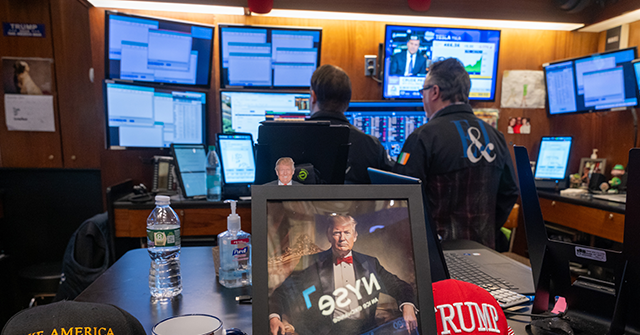


Time to Put Tax Cuts on the Front Burner
Treasury Secretary Scott Bessent is reportedly set to begin weekly meetings with congressional Republicans to shape a tax cut package. There’s not much time to spare.
It would be nearly impossible to exaggerate the economic significance of renewing provisions from the 2017 Tax Cuts and Jobs Act (TCJA) while also advancing President Donald Trump’s proposed additional tax relief measures, including eliminating taxes on tipped wages, overtime pay, and Social Security benefits. However, uncertainty around these policies is already having an economic impact, and further delay could exacerbate financial instability.
Recent market activity suggests that investors are reacting negatively to delays in securing tax policy. Last week, the stock market dropped 1,300 points, reflecting concerns that an extended period of uncertainty could slow business investment and household spending. Economic indicators show signs of softening, with the Chicago Fed National Activity Index (CFNAI) turning negative in January at -0.03, indicating below-trend economic growth. Slower production and consumer spending contributed to the decline, while employment-related indicators remained strong.
Larry Kudlow of Fox Business has highlighted the market’s reaction, arguing that the failure to prioritize tax cuts has already unsettled Wall Street. He notes that “only the GOP messaging coming out of the Senate right now has put tax cuts so far back on the back burner that they may well fall off the stove altogether.”
Kudlow emphasized that the market is sending clear warning signals, pointing to declines in consumer sentiment and sluggish retail performance. Walmart, for instance, issued a cautious outlook for the year ahead, and the S&P Global PMI suggests a cooling business climate.
A Bank of America report published last year that underscored the magnitude of potential economic consequences if these tax cuts are allowed to expire. The expiration would amount to a $4.6 trillion tax increase over the next decade, reducing GDP growth by an estimated 1.5 percent per year, according to Bank of America. With the economy expected by the Federal Reserve to grow around two percent per year over the next couple of years, this would be a serious blow to growth.
The individual tax provisions in question include the standard deduction, which would shrink from $30,000 to $15,000 for married couples, and the child tax credit, which would be cut from $2,000 per child to $1,000. Additionally, the expiration of the 20 percent deduction for small business owners could lead to an effective tax rate increase from 29.6 percent to 39.6 percent for many businesses. Higher estate taxes could also have a significant impact on family-owned enterprises, potentially forcing asset sales to cover tax liabilities.
These are not minor adjustments. The rollback of the TCJA tax relief measures would result in significant increases in tax liability for millions of Americans. According to the Tax Foundation, if the individual tax provisions of the Trump tax cuts expire, approximately 62 percent of taxpayers would experience a tax increase in 2026. That includes middle-income earners who, under current law, enjoy lower marginal tax rates, a higher standard deduction, and expanded tax credits. The elimination of these provisions would amount to a direct pay cut for many workers.
Consumer sentiment is already weakening, adding to concerns about how uncertainty is affecting economic behavior. The University of Michigan’s consumer sentiment index fell sharply to 64.7 in February, far below economists’ expectations. This marks a significant decline from December’s reading of 74 and suggests rising anxiety among Americans about inflation and economic stability. Higher food prices and ongoing uncertainty over tax and economic policy appear to be contributing to consumers’ hesitation, which in turn could slow economic activity.
Retail sales fell 0.9 percent in January, reflecting this growing hesitation among consumers. The index measuring expectations for buying conditions for durable goods plunged 19 percent, further suggesting that Americans are pulling back on major purchases. This aligns with increasing inflation expectations, which surged to 4.3 percent in February from 3.3 percent in January, the highest reading since November 2023. If consumers expect higher taxes and inflation, their spending will remain subdued, which could negatively impact business revenue and overall economic growth.
Small business owners are also beginning to show signs of hesitation in response to economic uncertainty. The NFIB Small Business Optimism Index fell by 2.3 points in January to 102.8, reflecting concerns about the future business climate. While still above the historical average, the sharp rise in the NFIB Uncertainty Index—up 14 points to 100—indicates growing apprehension. Small businesses, often at the forefront of economic shifts, are delaying investment decisions. Only 20 percent of business owners plan capital expenditures in the next six months, a sharp decline of seven points from December. Inventory investment plans also dropped significantly, with a net 0 percent of owners planning to expand inventory, down from a recent high in December 2021.
Although the Trump tax cuts do not expire until the end of the year, households will probably begin to prepare by pulling back on spending long before that. Businesses will likely anticipate that pullback, creating downward pressure on inventories, hiring, and fixed investment. The market will try to front-run both of these, calculating lower sales and profits into the price of equities. In short, the real economic deadline for providing clarity on taxes is not the end of the year but probably as soon as this spring and certainly no later than early summer.
The risks associated with prolonged uncertainty are clear. Economic indicators already suggest that growth is softening, and further delays in tax policy could add to market volatility. Bank of America’s analysis makes it clear that businesses and households alike are factoring future tax policy into their financial decisions. Any hesitation in securing tax relief could stifle economic momentum.
